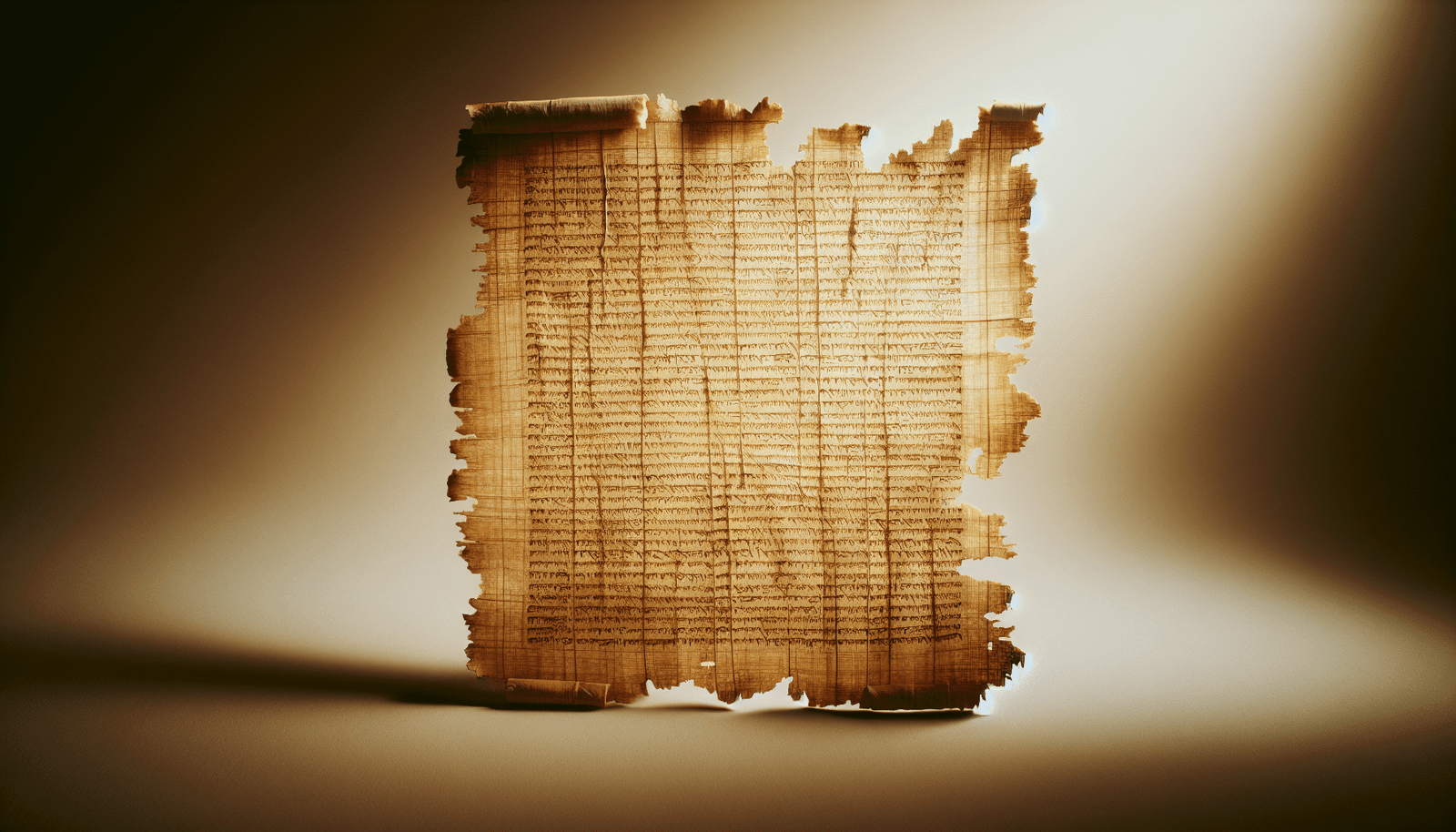Have you ever wondered about the deepest roots of Christianity and how those early biblical texts reached us today? The story of scripture is fascinating, especially with the discovery of ancient manuscripts like the John Rylands Papyrus. My name is Dr. Jane Doe, and I hold a PhD in Theology with over a decade of experience in biblical studies and manuscript analysis. This article will take you on a journey exploring the significance of the John Rylands Papyrus, a first-century gospel fragment that offers a unique window into the early days of Christianity.
Why is this topic crucial today, in 2025? As we progress deeper into the digital age, the importance of understanding and preserving these historical artifacts grows. Advanced technology allows us to study these precious documents in newfound depth, offering insights that were inaccessible just a few decades ago. Moreover, genuine scholarships ensure that these fragments are authentically understood, protected, and presented in context to the global audience. Our understanding of ancient texts not only shapes religious studies but also impacts cultural heritage and historical narratives.
TL;DR Box
If you’re short on time, here’s a quick overview: The John Rylands Papyrus, also known as P52, is a key artifact because it’s one of the earliest known New Testament fragments, dating back to the first half of the second century. It contains part of the Gospel of John and provides critical evidence for the New Testament’s early compilation and spread. The papyrus was discovered in Egypt in 1920 and is now housed in the John Rylands Library in Manchester, UK. Its study has had a profound impact on biblical scholarship and continues to be a focal point of academic interest.

The Discovery of the John Rylands Papyrus
Finding a Treasure: The Discovery Process
In 1920, what seemed like an ordinary day turned out to be groundbreaking for biblical scholarship. Archaeologists, during their exploration in the Egyptian sands, stumbled upon a small fragment that would later be known as the John Rylands Papyrus. This fragment was part of a larger collection found at Oxyrhynchus, an ancient Greek city renowned for yielding numerous papyrus texts. Unlike any other piece, this particular fragment bore a resemblance to Christian scripture, a rare find in this region known for more secular and administrative texts.
Transporting History: The Journey to John Rylands Library
Once discovered, this small yet potent artifact made its way to the John Rylands Library in Manchester. The library, known for its dedication to preserving significant historical documents, ensured the papyrus received meticulous care. It was here that careful analysis revealed its true importance—containing parts of the Gospel of John. The journey of this papyrus from the sands of Egypt to a dedicated manuscript vault in a library showcases the international effort involved in preserving our global heritage.
A Curious Mind: My Visit to the Manuscript Vault
The overwhelming sense of history you feel standing in the vault where the papyrus is stored is profound. As someone deeply involved in biblical manuscripts, visiting the John Rylands Library was like stepping into a treasure trove. The preservation practices implemented there are state-of-the-art, ensuring this papyrus and many other crucial documents remain intact for ages to come. It’s not just about looking at an old fragment; it’s about the stories it has the power to tell and the mysteries it may yet unlock.
What Makes the John Rylands Papyrus Special?
Dating Back in Time: Establishing the Papyrus’s Age
The John Rylands Papyrus holds special importance due to its dating. Radiocarbon dating and paleographic analysis have placed the fragment to the first half of the second century, making it one of the oldest New Testament manuscripts in existence. This dating is crucial because it narrows the gap between the life of Jesus and the physical evidence of written accounts of his teachings. It provides a tangible connection to the early Christians who first heard and recorded these words.
Textual Insights: What the Papyrus Contains
This tiny fragment, measuring only about 8.9 cm by 6 cm, includes portions of John 18:31-33 and John 18:37-38. Although small, these passages carry significant theological conversations between Jesus and Pontius Pilate, offering insight into the textual stability of the Gospel of John. Scholars examine these fragments to trace textual variants and better understand how these texts were transmitted through generations.
Pedigree and Provenance: Authentication
Authenticity matters immensely when it comes to ancient manuscripts. The John Rylands Papyrus has undergone exhaustive authentication processes, ensuring its legitimacy as a first-century artifact. Through various scholarly reviews and testing methodologies, including spectrographic analysis of ink and papyrus material composition, its authenticity remains uncontested. Such authentication reinforces its value not only to religious studies but also to historical and cultural scholarship.

The Impact on Biblical Scholarship
Bridging the Gap: The Role in New Testament Studies
The John Rylands Papyrus serves as a crucial touchpoint in New Testament studies. By bridging the chronological gap between the events of the New Testament and the earliest surviving textual witnesses, it affords scholars a closer look at the text’s early formation and dissemination across diverse early Christian communities.
A Textual Detective Story: Tracing Variants
The study of this papyrus also contributes significantly to the understanding of textual variants—the changes and differences found amongst copies of the texts. Such study helps scholars reconstruct the most accurate original text, providing a foundation upon which modern translations are based and ensuring an authentic transmission of these ancient writings.
Influence Beyond Academics: Cultural and Historic Significance
Beyond its textual and religious implications, the John Rylands Papyrus elevates the importance of early Christian writings as historical documents. They offer insights into the cultural and sociopolitical environments of the time, providing context to the interplay between emerging Christian beliefs and the world around them. These insights extend beyond religious study, impacting broader historical comprehension and cultural appreciation.
Exploring the Preservation and Visit Experience
Protecting the Past: Preserving the Papyrus
The preservation of the John Rylands Papyrus is a meticulous task, involving controlled environments that manage factors like humidity, light exposure, and temperature. These elements are crucial in preventing further degradation of the fragile papyrus material, ensuring that future generations can continue to study and appreciate its significance.
Visitation: Witnessing History First-Hand
For those able to visit the John Rylands Library, witnessing this piece of history is an extraordinary experience. Tours often include insightful discussions with scholars and experts who work tirelessly in the field of manuscript preservation. Seeing the physical text offers a connection to the past that books and replicas simply can’t replicate.
Digital Access: Bringing the Papyrus to the World
To balance preservational needs with public accessibility, the John Rylands Papyrus is available for digital viewing. High-resolution images and 3D models allow scholars and history enthusiasts worldwide to examine the text in detail without risking the original document. This digital access demonstrates a commitment to global scholarship and education.

The Future of Manuscript Studies
Advances in Analysis: Technological Contributions
Technology continues to play a transformative role in the study of ancient manuscripts. New imaging techniques, like multispectral imaging, reveal details invisible to the naked eye, such as erased texts or annotations. These advances not only improve our understanding of individual manuscripts but also aid in the broader reconstruction of historical contexts.
Global Collaboration: Sharing Knowledge
The study of the John Rylands Papyrus and texts like it is truly a global endeavor. Scholars from across the world collaborate, merging insights from theology, history, and science to piece together these ancient puzzles. International conferences and shared databases ensure that knowledge and resources are pooled for the most comprehensive interpretations.
Educational Outreach: Inspiring Future Generations
Efforts to incorporate manuscript studies into education inspire new generations of scholars. By integrating these studies into university programs and public educational initiatives, interest in ancient texts continues to grow. This outreach supports long-term efforts to preserve, understand, and appreciate the often-delicate threads connecting us to our past.
FAQs
What is the John Rylands Papyrus?
The John Rylands Papyrus, or P52, is one of the earliest known fragments of the New Testament, containing portions of the Gospel of John. It was discovered in Egypt and dates back to the first half of the second century.
Why is the John Rylands Papyrus important?
This papyrus is significant because it narrows the gap between Jesus’s life and early written accounts of the New Testament. It also helps confirm the accuracy and dissemination of early Christian texts.
Where is the John Rylands Papyrus located?
The fragment is housed at the John Rylands Library in Manchester, UK, where it undergoes meticulous preservation efforts.
How can I view the John Rylands Papyrus?
You can view high-resolution digital images of the papyrus online through the John Rylands Library’s digital collections. Limited in-person access is also available for the public.
How old is the John Rylands Papyrus?
Paleographic analysis suggests the papyrus dates back to the first half of the second century, making it one of the oldest surviving New Testament manuscripts.

People Also Ask
Is the John Rylands Papyrus genuine?
Yes, extensive authentication processes have confirmed its legitimacy as a first-century artifact.
How does the papyrus contribute to biblical studies?
It provides evidence of early New Testament text stability and helps trace textual variations, shaping our understanding of biblical history.
Can modern technology analyze ancient texts?
Absolutely. Techniques like multispectral imaging and digital modeling revolutionize our understanding of manuscripts, revealing previously hidden details.
Why was the papyrus found in Egypt?
Egypt’s dry climate helps preserve ancient texts. Additionally, the region was an early center for Christianity, making such finds more likely.
How does the papyrus connect to other historical documents?
It rests within a broader corpus of early Christian writings and artifacts, providing context to both religious and secular history of the period.
As we continue to unveil the mysteries locked within ancient texts like the John Rylands Papyrus, it’s clear their relevance and importance are undiminished in our modern world. Through collaborative scholarship and technological advances, our understanding grows richer, ensuring these fragile fragments of history endure for future generations.




